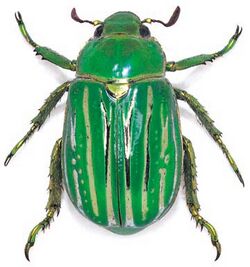Biology:Chrysina gloriosa
| Chrysina gloriosa | |
|---|---|

| |
| Scientific classification | |
| Domain: | Eukaryota |
| Kingdom: | Animalia |
| Phylum: | Arthropoda |
| Class: | Insecta |
| Order: | Coleoptera |
| Family: | Scarabaeidae |
| Genus: | Chrysina |
| Species: | C. gloriosa
|
| Binomial name | |
| Chrysina gloriosa (LeConte, 1854)
| |
| Synonyms | |
|
Plusiotis gloriosa LeConte, 1854 | |
Chrysina gloriosa is a species of scarab whose common names are glorious beetle and glorious scarab. It is found only in southern United States (southeastern Arizona, southern New Mexico and southwestern Texas ) and northern Mexico (Chihuahua and Sonora).[1][2] The adult beetles, which are active both day and night and primarily seen from June to August, eat juniper leaves and the larvae feed on decaying wood from Arizona sycamore.[1][3] A synonym formerly used for the species is Plusiotis gloriosa.[1]
The adult beetles are 20 to 30 millimetres (0.8–1.2 in) long,[4][5] and are bright green with silver stripes on the elytra (red and purple color forms occur but are very rare).[1] These iridescent stripes on the cuticle of the elytra are a result of cholesteric liquid crystal organization of chitin molecules.[6] The differences in color are a result of the microscopic structure of each section, with green reflected from cusp-like structures and silver reflected from flat layers parallel to the surface of the elytra.[7] As established through Mueller matrix spectroscopic ellipsometry,[8][9] the optical properties change with the incidence angle of the propagating light. The polygonal cells in the green stripes generate self-healing Bessel beams.[10]
The species is sometimes incorrectly thought to have been officially recognized as endangered,[11] but it has never been rated by the IUCN or listed under the United States Endangered Species Act. It can be locally abundant.[1]
References
- ↑ 1.0 1.1 1.2 1.3 1.4 "Species Chrysina gloriosa — Glorious Scarab". Bug Guide. http://bugguide.net/node/view/6605.
- ↑ "Chrysina gloriosa (Leconte)". Generic Guide to New World Scarab Beetles. University of Nebraska-Lincoln State Museum - Division of Entomology. https://unsm-ento.unl.edu/Guide/Scarabaeoidea/Scarabaeidae/Rutelinae/Rutelinae-Tribes/Rutelini/Chrysina/Chrysina-species/C-gloriosa/Cgloriosa.html.
- ↑ "Species Chrysina gloriosa". Bug Guide. https://bugguide.net/node/view/833514.
- ↑ "Glorious Scarab Beetle (Chrysina gloriosa)". insectidentification.org. https://www.insectidentification.org/insect-description.php?identification=Glorious-Scarab-Beetle.
- ↑ "Plusiotis (=Chrysina ) gloriosa". naturalworlds.org. http://www.naturalworlds.org/scarabaeidae/species/Plusiotis_gloriosa.htm.
- ↑ Pace, A. (1972). "Cholesteric liquid crystal-like structure of the cuticle of Plusiotis gloriosa". Science 176 (4035): 678–680. doi:10.1126/science.176.4035.678. PMID 17778170.
- ↑ Agez, G.; Bayon, C.; Mitov, M. (2017). "Multiwavelength micromirrors in the cuticle of scarab beetle Chrysina gloriosa" (in en). Acta Biomaterialia 48: 357–367. doi:10.1016/j.actbio.2016.11.033. PMID 27856284. https://linkinghub.elsevier.com/retrieve/pii/S1742706116306298.
- ↑ Fernández del Río, Lía; Arwin, Hans; Järrendahl, Kenneth (2014). "Polarizing properties and structural characteristics of the cuticle of the scarab beetle Chrysina gloriosa" (in en). Thin Solid Films 571: 410–415. doi:10.1016/j.tsf.2013.11.149.
- ↑ Ŕıo, L. Fernández del; Arwin, Hans; Järrendahl, Kenneth (2014). "Polarization of light reflected from Chrysina gloriosa under various illuminations" (in en). Materials Today: Proceedings 1: 172–176. doi:10.1016/j.matpr.2014.09.020.
- ↑ Bouchal, P.; Kapitán, J.; Konecny, M; Zbončák, M.; Bouchal, Z. (2019-12-01). "Non-diffracting light in nature: Anomalously reflected self-healing Bessel beams from jewel scarabs" (in en). APL Photonics 4 (12): 126102. doi:10.1063/1.5125045. ISSN 2378-0967. http://aip.scitation.org/doi/10.1063/1.5125045.
- ↑ Arnett, Ross H. Jr.; Richard L. Jacques, Jr. (1981). Simon & Schuster's Guide To Insects. New York, New York: Simon & Schuster. p. 108. ISBN 0-671-25014-0.
Wikidata ☰ Q5114611 entry
 |

